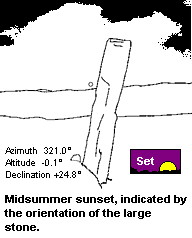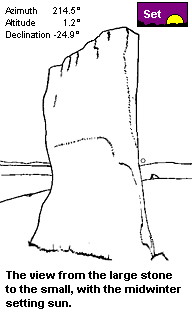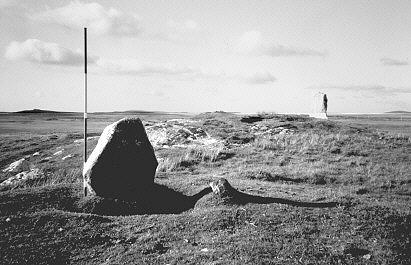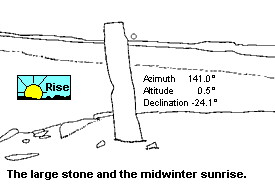
Cul a'Chleit, Lewis
Stones
of Wonder
QUICK LINKS ...
HOME PAGE
INTRODUCTION
WATCHING
THE SUN, MOON AND STARS
THE
MONUMENTS
THE
PEOPLE AND THE SKY
BACKGROUND
ARCHAEOASTRONOMY
USING
THE SITE DESCRIPTION PAGES
VISITING
THE SITES
THE
LEY LINE MYSTERY
THE
SITES
ARGYLL
AND ARRAN
MID
AND SOUTH SCOTLAND
NORTH
AND NORTH-EAST SCOTLAND
WESTERN
ISLES AND MULL
Data
DATES
OF EQUINOXES AND SOLSTICES, 1997 to 2030 AD
DATES
OF MIDSUMMER AND MIDWINTER FULL MOONS, 1997 to 2030 AD
POSTSCRIPT
Individual
Site References
Bibliography
Links
to other relevant pages
Contact
me at : rpollock456@gmail.com
Standing Stones NB247303
How to find: Travel
east from Garynahine on the A858 for 1km. Looking to the south, a small
rocky knoll can be seen with the standing stones on top. The walk of about
1.5km to the stones is over rough and wet moorland. Alternatively, after
visiting the site at Airigh nam Bidearan, walk downhill to the river and
cross the footbridge (you may have to remove and replace a sheep barrier
on the bridge to cross), then follow the river east (upstream) until close
to the stones, then walk up the hill. The site is also known as 'Callanish
6'.
Best time of year to visit: Summer solstice, winter solstice.
This isolated and unusual site requires a vigorous walk over very wet ground, but is easy to find, due to its position on a raised knoll which is visible for miles around, and it is well worth a visit.
There are two stones here, one measuring nearly 2 metres in height, and encrusted with lichen, the other being about a metre high. Both stones are set on the edge of the knoll; the stones do not have their flat faces aligned upon one another.
 It has been suggested that the two upright stones are all that survive
of a chambered cairn which once stood on the hillock, the cairn having
been robbed out to build the sheep fank and shielings just below the site
to the north-east¹. This may be true, but it equally likely that
the two stones represent an original free-standing setting.
It has been suggested that the two upright stones are all that survive
of a chambered cairn which once stood on the hillock, the cairn having
been robbed out to build the sheep fank and shielings just below the site
to the north-east¹. This may be true, but it equally likely that
the two stones represent an original free-standing setting.
The larger of the two stones has flat sides, which indicate to the north-west an azimuth of 321.0°. Together with a low horizon altitude it indicates a declination of +24.8°, and this is close to the position of the setting sun at midsummer.
 The
reverse bearing from this large stone of 141.0° with a horizon altitude
of half a degree indicates a declination of -24.1°, the position of
the rising sun at midwinter.
The
reverse bearing from this large stone of 141.0° with a horizon altitude
of half a degree indicates a declination of -24.1°, the position of
the rising sun at midwinter.
Even more interesting is the fact that from the position of the large stone looking towards the smaller a bearing of 214.5° is indicated, with a horizon altitude of 1.2°. The resulting declination of -24.9° is close to the position of the setting sun at midwinter.
Thus the rising and setting positions of the sun on the shortest day of the year are both approximately indicated at this site. Such a pairing of indications is rare. This is also unlikely to be the result of the coincidental survival of stones from a destroyed chambered cairn, but only archaeological excavation could resolve this.

Cul a' Chleit, small stone in foreground
